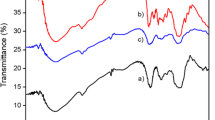Abstract
A three-phase suspension process was used for the preparation of gelatin beadlets containing succinylsulfathiazole. When the beadlets were hardened with 10% formalin at 5°C for varying periods of time up to 24 hr, the 6-hr hardening time gave the slowest release rate. Drug release rate from gelatin beadlets was slower in simulated gastric fluid (SGF) than in simulated intestinal fluid (SIF) but the sustained effect was too limited to be useful for most applications. When the hardened gelatin beadlets were coated with cellulose acetate butyrate (CAB) by an emulsion–solvent evaporation method, a more pronounced sustained effect and a nearly zero-order release were found in SIF. The effects of the amount of gelatin used, the amount of CAB employed, and the length of hardening time on drug release were investigated. The treatment of gelatin beadlets with formalin reduced the swelling action of gelatin in aqueous medium. A nonzero-order drug release rate was observed when the gelatin swelled sufficiently to rupture the CAB coating. The drug release rate can be adjusted by using different ratios of hardened gelatin beadlets and CAB coating in which the gelatin enhances the release rate and the CAB serves as a barrier.
Similar content being viewed by others
REFERENCES
L. A. Luzzi. J. Pharm. Sci. 59:1367–1376 (1970).
P. L. Madan. In T. Kondo (ed.), Microencapsulation: New Techniques and Application, Techno, Tokyo 1979, pp. 11–34.
J. R. Nixon and M. A. M. Hassan. Drug Dev. Ind. Pharm 7:305–316 (1981).
J. M. Conrad and J. R. Robinson. In H. A. Lieberman and L. Lachman (eds.), Pharmaceutical Dosage Forms: Tablets, Vol. 3, Marcel Dekker, New York, 1982, pp. 149–211.
S. Reynolds. U.S. Patent 2,183,084 (1939).
N. Tanaka, S. Takino, and I. Utsumi. J. Pharm. Sci. 52:664–667 (1963).
G. N. Paradissis and E. L. Parrott. J. Clin. Pharm. 8:54–59 (1968).
S. Goto, M. Komatsu, K. Tagawa, and M. Kawata. Chem. Pharm. Bull. 31:256–261 (1983).
S. E. Leucuta. Drug Dev. Ind. Pharm. 12:2281–2288 (1986).
J. R. Nixon, S. A. H. Khalil, and J. E. Carless. J. Pharm. Pharmacol. 20:528–538 (1968).
S. A. H. Khalil and S. S. El Gamal. Acta Pharm. Suec. 8:423–430 (1971).
P. L. Madan, D. K. Madan, and J. C. Price. J. Pharm. Sci. 65:1476–1479 (1976).
Author information
Authors and Affiliations
Rights and permissions
About this article
Cite this article
Chiao, C.S.L., Price, J.C. Modification of Gelatin Beadlets for Zero-Order Sustained Release. Pharm Res 6, 517–520 (1989). https://doi.org/10.1023/A:1015980809952
Issue Date:
DOI: https://doi.org/10.1023/A:1015980809952




